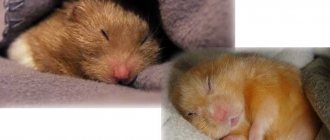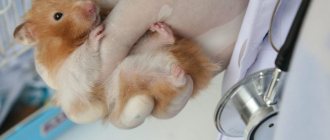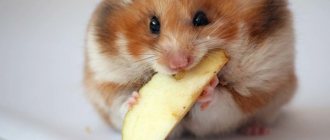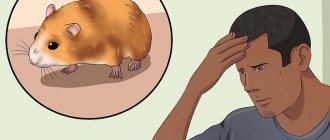When does a hamster fall on its back?
A fall should be understood as a sharp or slow rolling from the paws to the back. In this case, the animal may squeak or, conversely, make louder sounds. The accompanying symptoms will tell you what the main reason for this behavior is.
Fight with another hamster
It is known that these rodents love solitude and do not accept proximity to other animals, even of the opposite sex. The mating period between males and females lasts no more than an hour, after which two adults can fight even to the death. In this fight, the male often dies, since the female is by nature more aggressive and always considers herself the mistress of the cage.
Sorry, there are no surveys available at this time.
Many rodent owners are interested in the question of why hamsters fight and whether it is possible to make two males or two females coexist peacefully in the same cage. The answer is simple: no matter how many animals you have, each of them should have its own home, and nothing else. If you do put your pets in the same cage and notice that your hamsters are fighting, then move them out as soon as possible.
Disease
Another reason why a fluffy puppy falls on its back and rolls over may be the pet’s painful condition. If at the same time he squeaks, screams, or, conversely, looks lethargic and inactive, then you should quickly take your pet to the veterinarian to find out the reasons for this behavior. In the meantime, first examine the rodent: sometimes the symptoms of the disease are visible to the naked eye.
Swimming on land
Another reason why a pet can roll over on its back is a banal instinct. The fact is that in the wild, rodents bathe in sand in order to somehow fight parasites. These instincts are retained during their life in a cage. You don’t need to do anything about it, just monitor your pet’s behavior and health.
When a fluffy is bathed to clean its fur, it rolls on its back and twitches its paws, and then jumps up sharply.
Causes caused by incorrect temperature conditions
In order to understand whether the hamster is really sick if he does not move but breathes, it is worth carrying out a detailed examination. Attention should be drawn to the baby's eyes, breathing rate, and the naturalness of his posture. If your pet breathes calmly and steadily with his eyes closed, it is most likely that he is simply sleeping.
Heatstroke
It is known that individuals of the order of the hamster family, without exception, cannot tolerate heat or direct sunlight. Oddly enough, nature has deprived them of a system of protection against overheating; pets never sweat or breathe through their mouths like dogs. There are known cases where heat stroke resulted in death for animals.
To understand that your baby is overheated when he lies on his side and breathes heavily, you should pay attention to the presence of such signs as:
- no attempt to roll over or make any movements;
- lethargy;
- presence of seizures;
- impaired coordination of movements.
The likelihood of heatstroke occurring when your hamster is motionless and panting increases under the following conditions:
- improper transportation of the baby in personal transport;
- installing the cage on a balcony, window sill, in a place exposed to direct sunlight;
- installing the cage near heating devices;
- with high room humidity and stuffiness.
If you don’t immediately help your pet when he doesn’t move but is breathing, he may not be saved. For this reason, it is worth providing first aid to the animal, which is to:
- cool his body temperature - put the baby on a damp towel, tile, moisten his ears and paws with cool water. Do not rub frozen ice cubes or place them in water;
- inject subcutaneously 2 ml of water that the animal usually drinks to prevent dehydration;
- carry out anti-shock therapy - without waiting for the doctor, this should not be done. But if the ratologist is delayed, and the pet is getting worse, he can be given an injection in the hind leg (intramuscularly) of prednisolone 30 mg/ml with a syringe intended for administering insulin. The dose for a Syrian will be 0.1 ml, and for a Djungarian - 0.5 ml.
"Coma" or hibernation
If the hamster lies without moving, it is possible that the pet has fallen into a kind of coma, that is, into hibernation. His breathing remains calm and even, and his skin will be somewhat cool. In the wild, hibernation of individuals of the hamster order usually occurs in the winter season, when they need to survive cold, hunger, and decreased daylight hours.
The causes of “coma” can be the lack of food for several days in the absence of its strategic reserves, a heating shutdown or a sharp cold snap, which makes the apartment cool. The main signs that the baby is hibernating will be:
- closed eyes while breathing;
- cold but soft to the touch body;
- slow heartbeat (no more than a beat every 15 seconds).
In such cases, it is recommended to place the animal’s cage in a room where the temperature is equal to or above 20°C, and fill its feeder and drinking bowl. Within a few days, if all is well, the animal usually wakes up. If, after emerging from hibernation, he has impaired coordination of movement, which does not go away, he begins to sneeze, cough, or develops diarrhea, as evidenced by a wet tail, you should consult a veterinarian. And since it is undesirable to transport the baby after waking up from hibernation, it is better if he arrives on his own.
Related Issues
What to do if your pet not only falls, but also looks weak, makes drawn-out sounds and rolls his eyes? Most likely, this behavior is an alarming signal to contact a specialist.
In this video, the rodent funny turns over on its back.
Squeak or scream
Most often, a fluffy squeaks because it is experiencing pain or discomfort. This sound is difficult to confuse with another, since in case of danger or the presence of another rodent, the pet will make a completely different sound. What to do when you squeak? Examine your pet and observe its behavior.
Defensive stance
One of the reasons for a rodent falling on its back may be a defensive reaction. If a hamster begins to defend its territory from another rodent, it will often take a defensive stance. It allows the little hamster to appear more menacing and strong.
What exactly characterizes the stand:
- Falling on your back.
- Staying in one position for a certain period of time.
- Flatten ears.
- Raised paws up.
With these actions, your pet defends its right to territory and will fight for it to the end. You should not touch him in this state; there is a fairly high probability that the hamster may bite you. An animal in a fit of aggression may mistake you for an enemy, so be careful.
Video "Falling Hamster"
In this video, a rodent comically climbs and falls on its back.
Was this article helpful?
Thank you for your opinion!
The article was useful. Please share the information with your friends.
Yes (28.57%)
No (71.43%)
X
Please write what is wrong and leave recommendations on the article
Cancel reply
Rate the benefit of the article: Rate the author ( 9 votes, average: 4.44 out of 5)
Discuss the article:
Reasons for circling in hamsters
Circling in hamsters occurs when the hamster tilts its head. A drooping head is usually the result of an inner ear infection caused by bacteria, but there are other causes.
An inner ear infection causes bacteria from a dirty environment or respiratory infection to enter the ear canal. The pressure that an infection causes inside the ear canal can cause your hamster to lose balance and feel pain. This causes the hamster to spin around when walking, and some hamsters may even fall.
Neurological problems due to injury or brain disease such as epilepsy can also cause circling in hamsters. These problems are not as common as a bacterial ear infection, but are still possible causes of this behavior.
Diagnosis of the cause of the cycle in hamsters
Although hamsters circling may be an obvious behavior to observe, it may be necessary to perform some tests in order to know exactly what is causing it.
Since the most likely cause of circling is an ear infection, debris from your hamster's ear can be examined under a microscope. This will check whether bacteria caused by the infection is present and, if so, an ear infection will be diagnosed.
Neurological problems are more difficult to diagnose. If your hamster has recently been injured before circling, it may mean he has suffered a head injury. Falling, being grabbed by a dog, or colliding with a door or piece of furniture are all types of injuries that can cause a head injury.
Seizures are a symptom that overlaps with epilepsy, another neurological problem. There is no test for epilepsy. In these cases, constant close monitoring may be required and the veterinarian will be able to video record any unusual behavior.
When is the best time to start training?
The most important point in training is the age of the rodent. To achieve success, you need to teach tricks to a young pet, the optimal age is from 2 weeks to 2.5 months. It is during this period that hamsters are the most inquisitive, enjoy exploring the world around them and absorb information like a sponge, so they can be educated and begin to use commands for training. Older hamsters who have already established their routine, have become more thoughtful and less active, usually do not want to exercise, so they will not be able to achieve good results.
In addition to age, it is important to consider the health status of the rodent. You can start training if the hamster is active and has no signs of any disease. Animals should not be trained before or after mating, or during pregnancy.
The best period for training is the evening, when the rodent is more active and can easily perceive and remember new information. The process should begin with feeding - only on a full stomach can a hamster be distracted by entertainment; hunger leads to absent-mindedness, reluctance to communicate with the owner and loss of strength in the pet.
Important! Be sure to wash your hands well with soap and water, then use an antiseptic or wipe with lemon juice to neutralize any food odors that may distract your hamster.
Only a rodent that is accustomed to being handled can be successfully trained, so the basis for success in training a hamster is good contact with the owner, when the animal is happy to be held. For a good result, it is better to stay alone with the rodent - strangers in the room will distract the animal, it will become distracted and wary.
In addition to the above, follow these recommendations during the training process:
- always address the hamster by name to attract attention when saying a command;
- repeat the command several times without changing the wording, so as not to confuse your pet;
- speak calmly, kindly, make sure that the intonation for a certain command is always the same;
- repeat one exercise several times, only after that move on to another;
- at first, follow the order of the tricks you teach your hamster - this way he remembers better;
- Conduct training daily and always at the same time;
- Be sure to treat your pet with his favorite treat for completing the task correctly.
Treatment of circling in hamsters
Constant or severe circling in hamsters always merits a visit to the veterinarian.
If the behavior is caused by an ear infection, hamster-safe antibiotics will need to be prescribed as treatment. Without them, your hamster's ear may be permanently damaged and the circling may never stop. Infections can also lead to more serious complications, which in extreme cases can be life-threatening. Treatment of the infection may require oral antibiotics and sometimes pain medications. If debris is visible from the ears, gentle cleaning may also be helpful.
If the circling is not due to an ear infection, it may be more difficult to treat. Brain damage from seizures or head trauma may be permanent. Some circling will resolve on its own over time, but in some hamsters the circling may be permanent. If the circling is so bad that it is affecting your hamster's quality of life and he is unable to eat, then euthanasia can be discussed.
Sand bath - heaven for a hamster
If you decide to bathe your hamster in water, then you need to do this with extreme caution. Hamsters do not naturally bathe in water. The only suitable bath for a rodent can only be made of fine sand. It is while taking such a bath that you may notice that the hamster tumbles onto its back and back. This is explained by the fact that it is so inherent in nature, and the animal’s natural instinct is triggered. Sometimes it happens that a hamster can perform somersaults just like that, without sand, in this case you can prepare a sand bath for the baby. But nothing bad is happening to your pet at this moment, so you can observe his unusual actions.
We described in detail how to properly bathe a hamster in this article.
News about the disease
Another reason that a hamster falls on its back is the animal's illness. It happens that the rodent falls on its back and begins to squeak; often this behavior of the pet is accompanied by an unkempt appearance and decreased activity of the rodent. If your pet sleeps almost all the time, and when leaving its house it often rolls over on its back and squeaks, these are clear signs of health problems. In this case, it is best to take the animal to the veterinarian.
If the hamster has a neat appearance, is active, and easily walks in his arms - everything is fine with him, this is just one of the furry's amusements.
Why do caged hamsters often do backflips?
I can assume that it is precisely because he is in a cage (limited space) that he reaches the end of the cage, rests against the bars and, in order to avoid turning around again, does a somersault... he is bored in your cage, you need to put some kind of swing, the wheel is spinning, in general, keep the guy busy...
You can definitely feed. Not even because they are all rodents or anything else.
Hamsters, guinea pigs, mice, rats and hedgehogs will happily feed on them. But I don’t think this will be their regular diet? It would be nice for a hamster and a guinea pig to add some grass (hay, straw).
For rats, mice and hedgehogs, this will be a real delicacy. (I remember when I was a child we fed a hedgehog at home, an excellent catcher of crickets and cockroaches)
By the way, mealworms are a delicacy for them, and they rarely refuse animal food.
Of course, there are doubts about the difference between wild animals and animals from nurseries, but still they are animals and instinct will take its toll.
The most you can put on a hamster is a raincoat. But if you love your pet, then you shouldn’t do this, for people it’s a joke and a holiday, but for the animal it’s real torture. The cloak will get in the way and hinder his movements, no matter how well it is made, the hamster will feel discomfort and try to remove it.
Therefore, do not spoil the New Year for your hamster, but rather, arrange a holiday for him and treat him with something tasty)
Judging by Yandex pictures, Putin generally loves animals, which is usually (according to psychologists) a sign of some dislike for people. Leopards, dogs, horses, dolphins, tigers - these are perhaps the main types of animals in whose company he can often be seen. And for some reason he also likes to bottle feed calves.
No hamsters were seen in his environment. He probably just doesn’t notice them when he walks, and then there’s nothing to notice.
You can prepare different foods for hamsters.
People give hamsters not only dry food, but also prepare various tasty treats.
My friend loves hamsters and very often cooks different dishes for them.
Recipe No. 1 . Dry food, boiled chicken egg, spinach leaves. The egg is crushed, the spinach is also cut into small pieces, dry food is added, everything is mixed and given to the hamsters.
Advanced maneuvers
Weight lifting
Obviously, rodents should not lift heavy objects. But to create the effect of heaviness, you can make a barbell from foods that hamsters like to chew: carrots, cucumbers, apples, etc. A block is made from an oblong object; salty or sweet sticks can be used as this. Cookies can serve as mini pancakes for your attribute . When the pet sees the “barbell”, he will certainly want to chew on it, to do this he will lift it and a picture of an athlete with a lifted load will be created.
Pirate and parrot
To create the ambience of a pet sitting on the owner’s shoulder, follow the following instructions:
- Place your pet in your palm.
- Bend your elbow slightly and move it away from your body so that the rise is not too steep.
- Lure your pet to your shoulder with sweets and let your hamster eat it.
- Practice each step repeatedly with your pet.
- When the animal understands what the point is, stop luring the hamster with goodies. Instead, just give him a sniff of the food and immediately place the treat on his shoulder.
Soon your little friend will begin to willingly come running on your shoulder even in the absence of sweets.
Jumping through a hoop
If you want to see your animal jump over obstacles, then use a small hoop for this. The diameter of the circle must be at least 7 cm so that the hamster does not get stuck in it.
- Place the hoop between the animal and a piece of food.
- Keep the circle not too high above the floor (about 1 cm), otherwise the pet will run under it.
- Repeat the exercise several times until your pet can do it without a treat.
Barrier!
- Make a simple design from two disposable cups and toothpicks.
- Place a treat outside the barrier and say: “Barrier!”
- To get a tasty morsel, the fluffy will have to overcome an obstacle.
- After several strengthening of the skill, the animal will be able to jump over the barrier itself after a command.
Learning to do more difficult tricks
Only disciplined hamsters, previously trained in minimal skills, can learn to do more complex tricks. There are many difficult tricks for a hamster; below are the most spectacular of them, the training of which will be discussed in more detail.
Jumping through a hoop
Some hamsters are quite jumping and, if such a feature has been noticed in your pet, it can be trained to jump through a hoop. For rodents, you should choose a circle with a diameter of 7 cm so that they do not cling to the edges while jumping.
We suggest that you familiarize yourself with information about which is better to get - a rat, a hamster or a guinea pig.
Training begins by placing the hamster on a hard horizontal surface. A hoop is placed between the rodent and the treat, which is raised above the surface by a maximum of 1 cm. To get to the treat, the pet will have to jump, but you should not hope for a quick result - the most resourceful hamsters, seeing an obstacle in front of them, simply bypass it, so it’s better hold the hoop in your hand and follow the pet’s trajectory, forcing it to jump.
Overcoming obstacles
Performing a trick with obstacles that the hamster must overcome is based solely on the animal’s desire to enjoy the goodies with which it will be constantly lured. A purchased or home-made track with labyrinths, pipes and double-sided stairs is installed on a horizontal surface and, with the help of food, the rodent is stimulated to move along the track. At the end of the journey, the pet must be rewarded with a treat.











